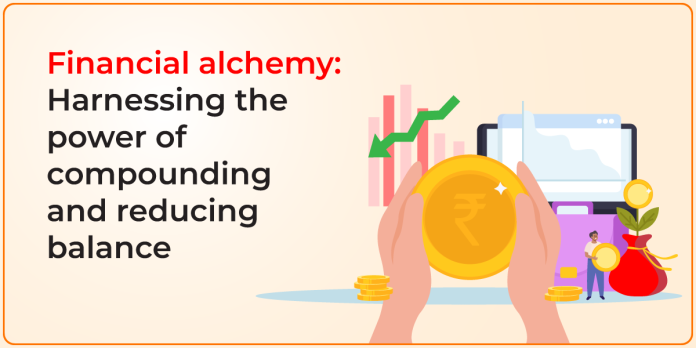In the vast world of money matters, two powerful concepts, the Power of Compounding and the Reducing Balance Effect, play crucial roles in shaping the outcomes of our financial decisions. Let’s embark on a simple journey where we explore a scenario involving a substantial loan and a Fixed Deposit (FD), both with an 8% interest rate, unfolding over 20 years.
The Loan Adventure: Reducing Balance Effect
Imagine taking a loan of Rs 1 crore with an 8% interest rate and a 20-year term. Here’s where the Reducing Balance Effect steps in. Unlike a flat interest rate, the reducing balance mechanism ensures that as you pay back the loan, the interest is calculated on the remaining balance. It’s like a snowball effect, where the interest burden gradually shrinks.
Here’s a snapshot of how it works:
EMI calculation-
Principle amount: Rs 1,00,00,000
Period: 20 years
Interest amount: Rs 1,00,74,562
Total amount payable: Rs 2,00,74,562
Monthly Loan EMI: Rs 83,644
Over the 20 years, the reducing balance effect resulted in a total interest payout of Rs 1,00,74,562, making the total amount payable Rs 2,00,74,562.
Power of Compounding
Now, let’s switch gears and talk about investing. Imagine putting Rs 1 crore in a Fixed Deposit with an 8% interest rate. Here, the Power of Compounding takes the stage. Compounding means that the interest you earn on your investment doesn’t just sit there; it earns more interest over time, creating a kind of money snowball.
Let’s see how it unfolds:
FD calculations-
Total Investment: 1,00,00,000
Interest rate: 8%
Period: 20 years
Est. Returns: Rs 3,87,54,392
Total Value: Rs 4,87,54,392
The Power of Compounding results in an estimated value of Rs 4,87,54,392 after 20 years.
Read: Equity Investment and Fixed Deposit (FD)
Making Sense of the Story
The intriguing part is the contrast between these two financial instruments. Despite having the same interest rate, the FD’s compounding effect propels the returns far beyond the loan’s reducing balance. It’s like planting a seed and watching it grow into a mighty tree over time.
The Reducing Balance Effect makes paying off a loan more manageable because, as you repay, the interest burden gets lighter. On the flip side, the Power of Compounding is like a magical money machine that turns your initial investment into a much larger sum over time.
This difference in outcomes is why businesses often opt for loans, using the reducing balance effect to manage their day-to-day operations. On the other hand, individuals with some extra money may choose to invest, taking advantage of the power of compounding to grow their wealth.
In the end, understanding these financial concepts helps us make smarter decisions. Whether it’s about taking a loan or choosing to invest, being aware of the interplay between compounding and reducing balance gives us the tools to navigate the financial landscape wisely. It’s a reminder that in the world of money, small decisions can have big impacts, and knowing the rules of the game can make all the difference.


